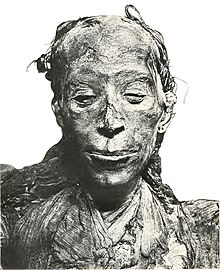Thuya, the mother of Queen Tiye, left a monumental legacy by becoming the grandmother of Akhenaten and Tutankhamun.
Thuya is believed to be a descendant of Queen Ahmose-Nefertari, and held many official roles in the intertwined religion and government of ancient Egypt. She was involved in many religious cults; her titles included ‘Singer of Hathor’ and ‘Chief of Entertainers’ to both Amun and Min. [4] She also held the influential positions of Superintendent of the Harem of the god Min to Akhmin and to Amun of Thebes. She married Yuya, a powerful ancient Egyptian courtier of the 18th Dynasty. She is believed to have died around 1375 BC, when she was in her early to mid-50s.

Children
Yuya and Thuya had a daughter named Tiye, who became the Great Royal Wife of Pharaoh Amenhotep III. The Great Royal Wife was the highest Egyptian religious position and served alongside the Pharaoh in official ceremonies and rituals.
Yuya and Thuya also had a son named Anen, who bore the titles of Chancellor of Lower Egypt, Second Prophet of Amun, Little Priest of Heliopolis, and Divine Father.

They may also have been the parents of Ay,[7] an Egyptian courtier active during the reign of Pharaoh Akhenaten who became pharaoh after the death of Tutankhamun. However, there is no conclusive evidence regarding Yuya and Ay’s parentage, although both men certainly came from Akhmim.[8]
Grave
Main article: Tomb of Yuya and Thuya

The mummy of Thuya
Thuya was buried in tomb KV46 in the Valley of the Kings, along with her husband Yuya, where her burial was found virtually intact in 1905. It was the best-preserved tomb discovered in the Valley before that of Tutankhamun, Thuya’s great-grandson. [9] The tomb was discovered by a team of workers led by archaeologist James Quibell on behalf of American millionaire Theodore M. Davis. Although the tomb had been looted in antiquity, much of its contents were still present, including beds, boxes, chests, a chariot, and the sarcophagi, coffins and mummies of the two occupants.
Thuya’s large gilded and black-painted wooden sarcophagus was placed against the south wall of the tomb. It is rectangular, with a lid shaped like the sloping roof of the Upper Egyptian per-wer sanctuary, and sits on ornamental skids, whose lack of functionality is underlined by the three slats fastened beneath them.[10] The ancient robbers had partially dismantled it to gain access to her coffins and mummy, placing its lid and one long side on a bed on the other side of the tomb; the other long side was propped up against the south wall. Her outer gilded anthropoid coffin had been removed, its lid placed on top of the beds, and the water trough placed in the far corner of the tomb; the lid of her second (innermost) coffin, also gilded, had been removed and placed to one side, though the water trough and her mummy remained within the sarcophagus. Quibell suggests that this is because the thieves had some difficulty removing the lid of this coffin.[2]
Mummy
Thuya’s mummified body was found covered with a large linen sheet, knotted at the back and secured with four bandages. These bands were covered with resin and in front of each band were her gilded titles cut from gold sheets. The layer of resin on the lower layers of the bandages preserved the impression of a large, wide collar.[11] The mummy bands that once covered her wrapped mummy were recovered from above the storage jars on the other side of the room.
The first examination of her body was made by Australian anatomist Grafton Elliot Smith. He found her to be an elderly woman, short in stature, 1.495 metres (4.90 ft) tall, with white hair. Both of her earlobes were pierced twice. Her arms are straight at her sides with her hands against the outside of her thighs. Her embalming incision is sewn up with thread, to which a carnelian barrel bead is attached at the lower end; her body cavity is stuffed with resin-soaked linen. When Douglas Derry, (who later made the first examination of Tutankhamun’s mummy) assisting Smith in his examination, exposed Thuya’s feet to obtain an accurate measurement of her height, he found that she was wearing golden sandals. Smith estimated her age at over 50 years based on her outward appearance alone. CT scans have estimated her age at death to be 50 to 60 years. Her brain was removed, although no embalming material was inserted, and both nostrils were packed with linen. Embalming packs had been placed in her eye sockets, and subcutaneous filling had been placed in her mid- and lower face to restore a realistic appearance;[12] embalming material had also been placed in her mouth and throat. Her teeth were in poor condition at the time of her death, with molars missing.[13] Previous x-rays had shown severe wear and abscesses.[14] Scanning revealed that she had mild scoliosis with a Cobb angle of 25 degrees. No cause of death could be determined.[13] Her mummy bears the inventory number CG 51191.[15]
Related Post
A shocking documentary proves that mermaids do exist
SHOCKING Revelation: Thuya, Mother of Queen Tiye, Was the Grandmother of Akhenaten and Tutankhamun—What Ancient Egyptian Secrets Did She Leave Behind?
Breaking News: Astonishing Discoveries at Karahan Tepe Confirm an Extraterrestrial Civilization is Hiding on Earth, and NO ONE Knows!
Breaking News: Researchers FINALLY Discover U.S. Navy Flight 19 After 75 Years Lost in the Bermuda Triangle!
NASA’s Secret Investigation: Uncovering the Astonishing Mystery of the UFO Crash on the Mountain!
Explosive UFO Docs LEAKED: Startling Proof That Aliens Ruled Ancient Egypt!